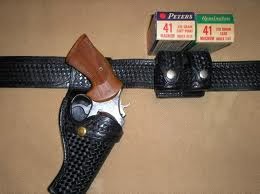The best source for locating pictures for the different types of grips would be some of the Smith and Wesson Forum groups, the S&W catalogue, and collectors. There are several different ones all over the internet and the members are filled with S&W facts and photos.
Essentially we are looking at several different types of grips on many different frames. To know them all is a stretch and they had some rare ones that even the best historians can't identify.
Tip-Ups:
The standard tip-up are all made of rosewood. These stocks are all smooth. The first stock on the left is for the Model One first and second issues with Square Butt. Model One 3rd issue with Round Butt; Model Two Old Army Square Butt; and Model One and a Half 2nd issue, Round Butt.(Jim King, Standard Catalog of Smith & Wesson)
.PNG)
Top Breaks: Top row left to right: Black Hard Rubber, .38 single action first model Baby Russian with S&W block logo; and red mottled hard rubber, .38 Double Action Second Model. Bottom row, Black Hard Rubber, .32 single action without logo; Red Mottled Hard Rubber, .32 Single Action with S&W Block Logo; Black hard rubber .32 single action with intertwined S&W logo; Black Hard Rubber, Floral Pattern, .32 Double Action; and Black Hard Rubber, .32 Safety Hammer less.(Standard Catalog of S&W 2006)
S&W small and medium top break stocks. Top row left to right; Black Hard Rubber, .38 Single Action First Model Baby Russian, with S&W Block Logo; and, Red Mottled Hard Rubber, .38 Double Action Second Model. Bottom Row, left to right; Black Hard Rubber, .32 Single Action, without S&W Logo; Red Mottled Hard Rubber, .32 Single Action, with S&W Block Logo; Black Hard Rubber, .32 Single Action, with intertwined S&W Logo; Black Hard Rubber, Floral Pattern, .32 Double Action; and Black Hard Rubber, .32 Safety Hammer less. ( Smith & Wesson Catalogue 2006)
S&W large frame top break stocks. Top Row: Red Mottled Hard Rubber, .44 Double Action, bottom row, left to right: plain walnut, Russian Round Butt; Black Hard Rubber, New Model Number Three, Round Butt; and Checkered Walnut, New Model Number Three Round Butt.
.PNG)
S&W Small Frame Hand Ejector Stocks. Top Row, left to right: Diamond Center Checkered Walnut, Regulation Police Extension Stocks, Pre-World War II (pre-war); and, Diamond Center Checkered Walnut, Regulation Police Extension Stocks, Post-War II
S&W K Frame Hand Ejector Stocks: Black Hard Rubber, Round Butt used 1899-1940; diamond center checkered walnut, round butt with silver medallions, post war used 1946-1950. Bottom row, Walnut Square butt, flattened top without medallions, used from 1904-1910; Walnut Square butt with recessed gold medallions, used from 1910-1920; Walnut Square butt round top with medallions used from 1920-1929; Walnut Square butt with silver flushed medallions used from 1929-1941.
S&W Diamond Center Checkered Target Stocks: Early Diamond Centered checkered walnut square butt without extractor relief cutout, used early 1950's; Diamond Centered checkered Goncalo Alves "Coke Bottle" Square butt, with extractor relief cut used about mid 1950's-1968. Diamond Center checkered Goncalo alves, Square butt, with extractor relief cut used about mid 1950's-1967.
S&W Checkered Target Stocks: Goncalo alves checkered target stocks with extractor relief cut, 1978, Goncalo alves checkered target stocks, with speed loader cut, 1981 and, resin impregnated laminated birch checkered target stocks with speed loader cut from the early 1990's.
S&W Plain Target Stocks, early smooth rosewood coke bottle, square butt without extractor relief cut, used early 1950's. Smooth Goncalo alves, square butt with extractor relief cut used about 1967-1980. Smooth rosewood square butt with speed loader cut without stock circle insert used about 1970's- 1990's.
All of these photos and information that follows them comes right out of the Smith & Wesson catalog and authors are Jim Supica & Richard Nahas 3rd edition. 2006 Gun digest books Iola, WI
.PNG)
.PNG)




.PNG)














.jpg)











